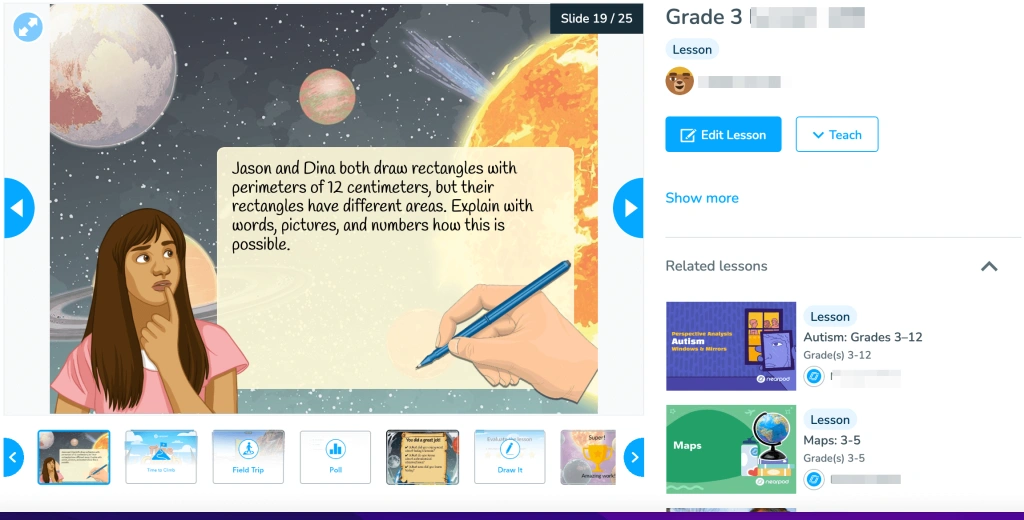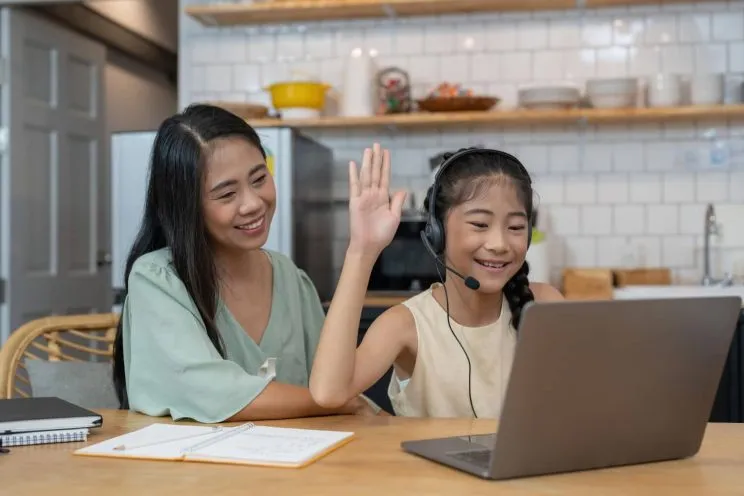Remote Learning: Pros and Cons
reviewed by Jo-ann Caballes
Updated on November 4, 2025
Since the COVID-19 pandemic hit the world in 2019, remote learning has become an important part of the educational process. But it wasn’t the only reason: advancements in technology and changes in educational practices have made remote learning extremely popular. Even if there’s no need to avoid on-site learning, students prefer online classes. However, along with the obvious advantages, remote learning also has its drawbacks. In this article, we explore the pros and cons of online education, provide tips on boosting the benefits of remote learning, and look into its prospects.
What is remote learning?
Remote learning, also known as distance education or online learning, is an approach to learning in which educators and students interact via online platforms or video conferences, hence virtually. It also refers to using technology that facilitates education outside of traditional classroom settings.
It has completely changed the way people learn and get an education, erasing geographical barriers and offering opportunities for those who don’t have access to the facilities. It also revolutionized how working professionals and people with disabilities pursue their educational goals.
What benefits does remote learning offer?
Remote learning offers great flexibility and comfort for students and educators. Virtual learning allows them to connect and access educational resources without leaving their homes. Students now also have access to a wide range of educational materials: interactive exercises, lectures, books, and educational videos, available to them anytime, anywhere.
Remote learning is typically used when scheduling conflicts, illnesses, or states of emergency occur. Although it is fairly new and innovative, more and more people have become accustomed to it in education since it’s fairly similar and doesn’t require commuting, getting ready for, or much in-person interaction.

Furthermore, remote learning has been shown to be an indispensable tool for professional development. Even with a full-time job, people are now able to squeeze in online classes that allow them to pursue higher education or professional training without the constraints of time and location. Regardless of their background, online education helps people access more learning opportunities.
What is a remote class?
A remote class is an approach to learning where teachers meet with their students and classes through video conferencing platforms like Zoom, Skype, Google Meet, or other teaching platforms. It means that participants located in different places have an opportunity to interact with each other with the help of computers, tablets, phones, or other devices. In many organizations, the same virtual setup is also used to run an employee recognition program, helping remote teams celebrate achievements and maintain a sense of connection despite working apart.
Remote classes allow us to cover almost all levels of education, for example, from school lessons to university lectures and corporate training. Teachers can give entire lectures through video conferencing, while others use it solely to check in on students to make sure they understand the material and to help them in case of any questions. The frequency educators use to teach via video conference may differ significantly among schools and states, but it obviously serves as a significant tool in online learning and the overall education process.
How does a remote class work?
Remote classes will also require students and teachers to be present online on the same day and at the same time, just as they would in an offline setting. The teacher will present the lecture via Zoom, Google Meet, or any other convenient platform, while students attend from a remote environment like their bedroom, kitchen, or a co-working space. This is a great opportunity for students who like to ask questions while the lesson is in session, as the material is presented in a live and interactive environment. Another fascinating thing about remote classes is that students can do interactive tasks together, all in a virtual space.
Does it require students to be present at the lessons at all times? Not necessarily.
The idea is that remote classes are usually recorded. So, if students miss the class for whatever reason, they can go back to it once the recording is ready. On the other hand, students are responsible for reviewing the class afterward, as well as completing assignments, quizzes, and homework. They usually have deadlines, so students have to be cautious and manage time effectively; nonetheless, they are still offered more flexibility in terms of when they complete those requirements.
Generally, the success of remote learning depends largely on students, even though it’s perfect for those who learn best by using recorded and written resources provided by the educator.
Whether delivery method students choose, it’s important to know that both remote and online learning will require diligence and dedication, as well as discipline and readiness to take control of their learning journey. If they feel uncertainty or stress over certain aspects of remote classes, it’s important to seek advice from your counselor.
Math remote learning with Brighterly
Brighterly is an online math learning platform offering online math classes for children aged 6 to 18. It prioritizes play-based education: having its own teaching platform, Brighterly encourages kids to learn through a combination of interactive resources such as games, videos, and worksheets.

It means that even with remote math classes, your kid won’t just sit and listen to what the tutor says, but rather, they’ll be actively engaging in all of the interactive assignments. Since the learning sessions are primarily remote, your kid will be able to learn math from anywhere in the world at a convenient time. All you need is a tablet or a computer and an internet connection. From there, there are no limits to how far you can go with Brighterly.
Is math learning through remote classes effective?
Yes, with the right resources and strategies in place, math learning through remote classes is effective. Here is the list of factors that contribute to the success of remote learning:
- Quality Instruction
- Interactive Tools
- Engagement and Interaction
- Regular Feedback
- Personalized Learning
- Flexibility and Convenience
Quality Instruction
Brighterly’s math tutors have extensive expertise in online tutoring, which ensures the best quality of education. We provide students with high-quality video lectures, clear explanations, and interactive teaching methods, and we are proud to say it makes a significant difference in their math learning experience.
Interactive Tools
Hands-on activities, interactive workbooks and worksheets, virtual manipulatives, math games, and dynamic geometry software help students grasp complex math concepts. Brighterly’s goal is not to make your kid memorize models and frameworks but to enhance understanding.
Engagement and Interaction
Interactive elements such as games and assignments boost your kid’s interest in math. Not to mention the built-in brain breaks that help reset your child’s focus and prepare them for the next chunk of material.
Regular Feedback
Bighterly’s tutors encourage parents and students to share their feedback and experiences to better understand their progress and identify areas where students may need additional help.
Personalized Learning
Brighterly aligns its curriculum with US school standards, but it also caters to students’ individual learning needs via adaptive learning. That means that every lesson is personalized and can be adjusted to your kid’s knowledge gaps, skills, and character.
Flexibility and Convenience
Another important thing about remote math learning is that it can offer a lot of flexibility. Brighterly offers a flexible scheduling system, allowing you to plan lessons according to your convenience and availability.
How does remote learning work?
The typical structure of remote learning is different around school districts, but it usually involves using learning management software such as Google Classroom. This is an optimal way to share information, assignments, tests, feedback, etc. Every school can choose a specific learning management software.

Distance learning typically requires participants to log in to a specific learning management system, where they can access the course content and support material, check their grades, and connect with classmates. Teachers generally post daily assignments that students have to complete, but that can vary. If students or parents have any trouble using the learning management system, schools offer in-depth how-to guides to support them along the way.
Generally speaking, students have to remain online for a specific amount of time, but the timing can vary from school to school. Students have to complete their assignments on time (daily or weekly) and send them back for the teacher to evaluate. When the teacher checks the work, they provide feedback to each student via the learning platform.
The main structure of remote learning is quite straightforward: login, lecture, task, and evaluation. Despite its simplicity and flexibility, remote learning can be confusing when students lack discipline and the ability to manage their own time.
Is remote learning effective?
If you wonder whether remote learning works, we’re here to tell you that it appears to be pretty effective. 2021 research suggests that distance education is as effective as face-to-face (traditional) learning in terms of student learning outcomes.
4 reasons why remote learning can be more effective than face-to-face training
Faster Learning Pace
Since remote learning gives students more control over their learning, they are able to move at their own pace. And let’s face it, some students can learn and gain skills much faster than others. They are also able to progress faster through areas they feel comfortable with or have knowledge of, and vice versa.
Less of a Time Investment
Traditional classroom settings involve a lot of moving around, i.e., looking for the classroom or waiting for other students to join. Commuting back and forth also requires additional time, which can lead to frustration and a lack of motivation. Remote learning allows both teachers and students to split the time they are investing in the course in whichever way works for them.
Less Distraction
Regular short tests, which are usually the case in remote learning, can improve student engagement. Systematic assessments help students ease into the educational process, allowing them to have a more structured schedule. As a matter of fact, research from Harvard demonstrated that implementing short, regular tests halved student distractions, tripled the amount of note-taking, and significantly improved students’ overall retention of the content.
Eco-Friendly
Not only is remote learning effective for students, but it’s also a greener option. On average, online courses use 90% less energy and 85% fewer CO2 emissions per student than traditional in-person courses. That might be an important point for people wanting to lead a more environmentally friendly lifestyle.
In summary, remote education is fairly effective due to an increased understanding of the material, a comfortable and adjustable learning pace, and the absence of limitations of time and geography.
Benefits of remote learning
There are numerous advantages of remote learning. Dr. Richie Romero, Deputy Superintendent at California Online Public Schools, shared with us his outlook on the remote learning advantages:
“A key benefit of remote learning is the personalized approach to learning.”
He also emphasizes that an online-only environment enables teachers to develop 1:1 relationships with students and families through regular, weekly individual meetings with each student.
Let’s explore some of the advantages of remote learning:
Personalized Experience
Remote learning offers the possibility of a more personalized learning experience. Students can move at their own pace, not needing to rush themselves or wait for other students to catch up. It means that even with a clear and defined structure, students have the ability to focus on areas that require more attention or otherwise spend less time on topics they already understand.
Additionally, they can replay the lecture as many times as necessary to grasp the concepts fully. That promotes more control over their own education without frustrating feelings like a rush or inability to catch up. This tailored approach fosters a deeper comprehension and a better understanding of the material.
Flexibility
Remote learning provides much flexibility and convenience. This is especially advantageous for working professionals, parents, and people with other commitments, as it enables them to balance their work, personal responsibilities, and education effectively. Being able to study anytime is great for those whose circadian rhythms might differ from a classical 9 to 5 schedule. This is especially beneficial for kids who have trouble keeping their focus early in the morning, as remote classes don’t require them to spend time commuting to school. This ease not only saves time but also minimizes the stress related to daily commutes, both for children and parents.
Cost-Efficiency
Online learning allows students to save money on expenses like housing, commutes, and textbooks. Also, online courses are often more affordable than face-to-face programs, making education more accessible. Students can also save money on expensive physical books, as online courses often provide digital textbooks and resources.
More Beneficial for Visual Learners
Students who prefer visual tools are thriving in online learning. The visual nature of online learning infuses their learning style through visual pedagogical models.
Inclusivity
Perhaps the most important advantage is that remote learning offers plenty of opportunities for people with disabilities. Some classes are simply not equipped to provide a comfortable learning space for people who need that.
Dr. Richie Romero says that the popularity of remote learning will continue to grow in 2024:
“Remote learning has an important place in the educational system.”
By the 2022-2023 school year, this number has increased to 564,235 (SNAPSHOT 2024 report). Additionally, the number of states offering full-time online school options has increased from 36 in 2023 to 40 for SY 2024-2025. This reflects a continued trend towards more widespread acceptance of online education options and a response to the evolving educational needs of students.
Disadvantages of remote learning
While remote learning has an array of advantages, it’s not perfect. Let’s review some of the disadvantages of remote learning:
Limited Social Interaction
Remote learning lacks social interaction since everything happens via video conference. Students fail to connect with each other, which can affect their social skills. This can be a downer for both students and teachers, as they are unable to communicate face-to-face. It can also stunt students’ growth in learning, leadership, social skills, public speaking, and more.
Technological Problems
Remote learning goes hand in hand with tech issues and connectivity problems. Especially when affects the lecturer or a teacher, count that session out. This can lead to frustration and significantly affect how the overall educational program goes.
Less Motivation
Some students can struggle to feel motivated during remote learning. Even strong learners tend to lose their focus in remote learning environments, especially when the subject is not their favorite. Moreover, teachers fail to identify who might need additional help or attention, which can lead to bad grades as a result.
No Classroom Dynamic
The school experience can be wonderful for most students. However, remote learning can’t provide students with the same level of involvement and engagement, which is difficult to achieve in remote settings. Those little rewarding moments like classwide laughter or the look on children’s faces when they finally understand something are not the case during remote learning, which can bring both students and educators down.
Conclusion
To sum up, remote learning has changed how we see education forever. It does offer a lot of advantages, but it doesn’t come without its share of challenges. Personalized learning, flexibility, and accessibility make it a great option for many students, especially those who may be unable to move places or find time to commute.
With online learning platforms, students don’t feel the drop in engagement, making remote learning as efficient as traditional learning. Still, problems like the lack of social interaction, potential technological issues, and the need for strong self-motivation aren’t going anywhere and present significant challenges to most students. However remote learning is tightly integrated into the educational system now, but that doesn’t mean that it will replace traditional methods.
Online learning platforms like Brighterly offer parents and children to enjoy a fascinating experience and benefits of distance education. If you are looking for the best online math courses to teach your kid with a one-on-one approach, Brighterly is an obvious choice.
Book a free demo lesson with Brighterly and see how easy it is to make your kid love math!

















